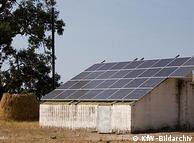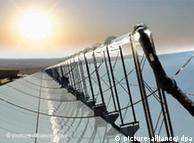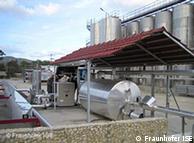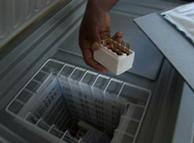ALTERNATIVE ENERGY | 09.06.2011
Cooling with the heat of the sun
"Cooled by sunlight" are words that might well be found on food packaging of the future, since solar cooling units that keep fruits and vegetables fresh, and edible, longer, are now a reality.
The solar cooling technology could be especially beneficial to people in developing countries, where refrigerators are often unattainable luxuries and then only available in urban areas that have reliable electricity networks.
Keeping medicines cool is also a crucial issue in many poorer countries, particularly in rural regions.
Researchers at the Fraunhofer Institute for Solar Energy Systems (ISE) have demonstrated that solar cooling is now a reality, even in hot countries.
As a part of the EU-backed MEDISCO (Mediterranean Solar Cooling) project, ISE scientists set up solar installations in a winery in Tunisia and a Moroccan dairy.
"The technology is very useful in sunny countries, especially in remote areas, where conventional cooling methods are difficult or impossible given the lack of water or the absence of a reliable energy source," said Tomas Nunez, a Fraunhofer ISE researcher.
"Solar cooling is environmentally friendly and greatly reduces the need for expensive electricity to power conventional refrigerating devices," he added.
Researchers have set up large solar collectors which use mirrors to focus sunlight on an absorber. The concentrated solar radiation heats water in a container to 200 degrees Celsius, which then drives a so-called "absorption chiller" that creates chilled water used to cool a space.
"Unlike refrigerators we don't use electricity to create cold, but heat," said Nunez. "It is cold in the form of cold water or, in our case, a water-glycol mixture."
Market barrier – cost
Many trials to cool rooms or entire buildings with the solar units have been successful and shown that solar systems can use from between 50 to 80 percent less energy than traditional air conditioning systems.
However, despite the obviously environmental advantages, experts warn that the technology is not yet ready for the market.
"The costs involved in installing these complex systems are simply too high," said Professor Ursula Eicker of the University of Applied Sciences in Stuttgart.
 Solar cooling can be especially helpful to rural regions without reliable power sources
Solar cooling can be especially helpful to rural regions without reliable power sourcesA solar cooling system in a single-family house in Germany or Austria will cost between 30,000 and 40,000 euros ($44,000 and $59,000), double the price of traditional air conditioning.
While that would discourage many Europeans, for an average mid-sized company in Africa, such an investment is often out of the question. In addition, the installation costs of an industrial system are even more daunting.
Still, most researchers say development in the sector will take place largely in the industrial sector. Nunez, for one, is optimistic about the technologies chances in the mid-term, especially in helping air condition buildings in hot, sun-rich places like Africa.
"The important thing is to promote the technology slowly, step by step," he said, stressing the need to spread awareness of solar cooling with sponsored projects and getting local people involved.
"Part of the production should take place at the local level, and you need trained engineers for the installation," he said.
Getting the government on board
Without state backing, like exists in Germany, Spain and Austria, solar cooling systems will never be competitive.
"We are in an absolute niche," said Eicker.
In 2007, 81 larger solar refrigeration machines were installed worldwide, almost all of them in Europe, and most of those in office buildings.
In order to create a market for the technology, governments have to show interest and step up to the funding plate, experts said, like is happening now in Egypt and Morocco.
Despite the costs, replacing conventional cooling systems, and preventing the installation of many others in emerging countries, is essential to environmental protection. Refrigerants and foam blowing agents contain ozone-eating chlorofluorocarbons (CFCs), which are 12,000 times more damaging to the environment than carbon dioxide.
European governments are now helping some developing countries replace these substances with more environmentally friendly variants. Such efforts were kicked off by the Montreal Protocol, an agreement signed in 1987 that committed 180 countries to helping phase out these ozone killers.
To this end, the German government initiated the Proklima project, which introduces and disseminates environmentally friendly technology in developing countries that neither harms the ozone layer nor contributes to global warming.
The project has partnered with 40 nations, including Swaziland, where local businesses are manufacturing new, "green" refrigerators.
All in all, the initiative has prevented some 46 million tons of CO2 from being emitted into the atmosphere.
Author: Torsten Schäfer (jam)
Editor: Ranty Islam
Editor: Ranty Islam
dw




No comments:
Post a Comment